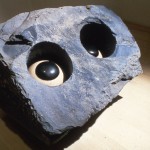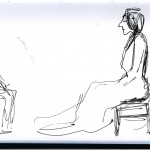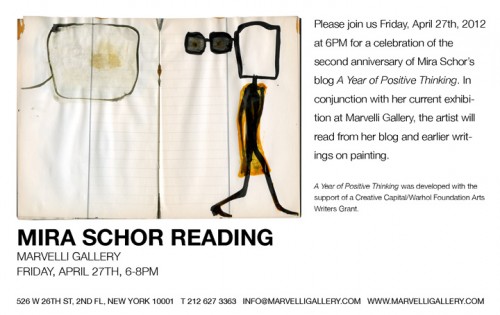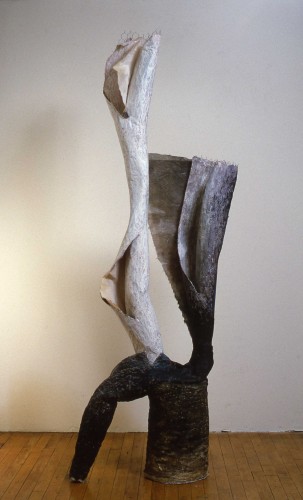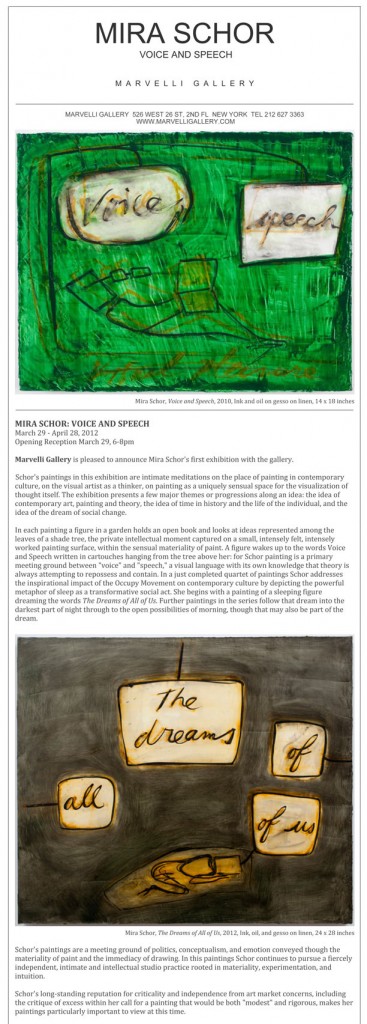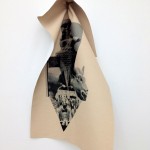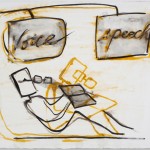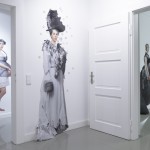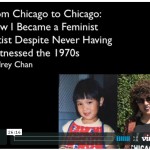Yesterday the New York Times Sunday Review lead editorial was “The Campaign Against Women.” The editorial focused on a number of recent state and federal laws put forward and passed by Republican legislative majorities affecting women’s reproductive rights, healthcare, equal pay and domestic violence protection, among others (and they didn’t even mention recent laws requiring transvaginal ultrasound probes for women seeking abortions).
I posted the Times editorial on Facebook with the query “is there still a need for “Woman”-focused feminism or would other theories and political positions be more useful?” This query partially emerges from instructive and provocative conversations I had with some of my students this past semester in a course on Feminist art practice about a range of political and theoretical identifications and positionalities some of which I experienced as being in stark contrast to the actualities of female experience around the globe as well in our own seemingly privileged culture.These conversations suggested more study and rethinking, and, if I’m not sure I can alter some of my deeply held views, I see in renewed focus other points of views that I need to rethink and study further.
The ensuing comments thread is an example of what can occasionally make Facebook an interesting space for discussion among people who are not in the same room and who may or may not have ever actually met, beyond its role monetizing your personal data for the benefit of Facebook. The people who participated, some of whom rarely “speak up” on Facebook to my knowledge, were articulate, informed, and clearly cared deeply about the issues raised. I learned from their comments and responses in this thread, as participants discussed some of the parameters of the impasse in which feminism occasionally seems trapped, between developments and positions on the “left” and the “right.” With the permission of my Facebook friends who participated I am republishing this comments thread here, to expand the readership. I have done this once before, in the spirit of extending conversation when it seems worth it: I would encourage anyone who wants to engage in this discussion to do so on the Facebook comments thread and I will add them to this blog entry if they continue the discussion in a productive way.
Fung-Lin Hall: I just posted for John Stuart Mill… he was for women’s rights.
Tracey Harnish: I was just talking about this with another artist. How young women do not seem like to like the term feminism. It seems like something new is needed, but what? This regressive Repub stance is unbelievable!
Lori Ellison: OWS is forming a feminist movement inside of the ideas already percolating.
Ula Einstein: good question Mira! I don’t have an answer yet. and Tracey, I wonder if young women don’t like it because they don’t fully understand the history; although Feminism is not a word I use much either. I am completely interested in who and how we are as women c0-creating change, consciousness and culture. hmmmmmm.
Mira Schor: I may be misinterpreting them but this semester in my Feminist Art Practice course my students and I had a heated discussion (well, I was heated) over a statement made during the conference I hosted at Parsons (*at the moment the conference is partially online–please note introduction for order of speakers which appear as individual videos–but not the discussion segments, when these go online I will link to them), where one participant said she had no trouble with the identification feminist, but she did have a problem with the identification Woman, this was related to a queer identification and queer theory/discourse, adopted by most of the students whether gay, queer, transgender, or straight, & some at least still had some issues with the term feminist although of course they would agree with feminist political points of view. It is most curious. My point was that when the most brilliant minds of a generation in a relatively privileged culture take that position (I’m thinking of people like Judith Butler who many of my students idolize, for her gender work as well as more recent writings on war, non-violence etc) , then when women’s rights are under assault, there is no discourse to defend them, because discourse has migrated, in this case, to queer rights, which are important, but I do not think are the same thing, and so feminist activism seems to be disabled…I could go on and on, as my students discovered with some alarm!!!
Ula Einstein: again, thanks for letting us know the Context: Mira: I don’t think they’re the same thing either. and yes: then when women’s rights are under assault, there is no discourse to defend them, because discourse has migrated, in this case, to queer rights, which are important, BUT I DO NOT THINK ARE THE SAME THING, and so feminist activism seems to be disabled
Lori Ellison: Feminism is more important than ever. I heard an interview with the creator of the TV show Girls on Fresh Air and Terri Gross said at her age they were pressing to be called women. Dunham blithely glided over that. I think there is a gathering storm over the War on Women as the media has called it. And Obama. There will be a lot of women who in earlier times were able to take certain things for granted and never think deeply about feminism that will now.
Donna Ruff: I heard that interview too, and am kind of horrified by the series- I don’t mind being referred to as a girl, having gone through the woman era, but the humiliating and confused actions of the girls on the show- if this is indicative of a generation it makes me very sad. Of course it’s fiction but is this a piece of the anti-feminist, anti-woman zeitgeist?
Lori Ellison: Yes, the internalized backlash.
Mira Schor: Donna I don’t get HBO, but friends have told me about how disturbing it is to see the young women on Girls accept totally degrading sex without question making the women on Sex and the City positive feminists for insisting on their own pleasure! it is worrisome if a generation of women raised during the Reagan/Bush/ and yes the Obama years would allow so much of the misogyny always threatening to overwhelm any civilization to go unquestioned and unopposed. The less clear opposition and questioning there is, the more years to again denaturalize that misogyny.
Monika Weiss: For years I thought in the West there was no more need for “women focused feminism” because we were on a different level of fighting otherness and underprivileged conditions, as opposed to some non-Western countries and continents, where women focused feminism was and is still a necessity. In light of recent developments here on the Right, with their attempts to undermine most of the women rights we have achieved in the 20th century (short of preventing us from voting–but perhaps this is coming as well, since the other legislation debated now is as absurd as voting prevention, perhaps because voting is not good for raising kids, and takes our female minds –if there are any –away from the households) — thus I have to admit that yes, we do need, once again, fully on, a “women focused feminism”, which would be positioned under the agenda of defending human rights as such.
p.s. There are good reasons why so many of our students love Judith Butler and especially her more recent books on war and violence — perhaps because there are connections, some obvious and some more hidden from general view–between oppressive systems that treat woman as an under-class, under-human, and other forms of oppression such as war (which in Butler’s terms is always already a crime) with those “not grievable” lives. I think this is a time not only for “women focused feminism” but a larger critique of a culture or civilization that makes possible a reversal of human rights. This is a great question by the way, thank you Mira for asking it.
Donna Ruff: The alarming thing is that it’s no longer something to be identified as a movement by those on the Right, because the Right has migrated to the center. As for the series, it’s not just degrading sex, but sex with no feeling whatsoever. Along with a sort of nihilist drifting through life and relationships.
Mira Schor: Donna I don’t think the Right has migrated to the Center, the Right has migrated to the extreme right, and everyone else has moved right accordingly, so that today’s “center” is basically mid 20th Republican or worse. For example many of Nixon’s domestic policies would today be perceived as left, even socialist by the standards of the more rabid Republicans, whereas many agree that Pres. Obama basically has the policy outlook of a moderate Republican pre. Gingrich.
Donna Ruff: Yes, after I posted that I realized I had worded it badly! What I meant was that these attempts to deny women’s rights through legislation aren’t coming from some right wing extremists, but from the House Speaker and Republicans who should have more moderate, and Representative (ironic use of word) views. So that the so-called Right has spread like a mutated virus.
Monika Weiss: This is of course true-we have lost the Left in this move towards the Right and extreme Right. how to position the feminist movement now, in this context of loss of Left?
Terry R Myers: Mira, I assume you know Monique Wittig’s essay “One is Not Born a Woman”? I’m curious if the student in your class that you mention above knows Wittig’s work?
Mira Schor: Hi Terry, thanks for the reference to Monique Wittig’s essay “One is Not Born a Woman”. I don’t have a copy of the essay (do you happen to have a PDF?). I can’t speak for whether my students would agree or disagree, though on the face of it, most likely would agree. There just seems to be a very fine line between several verities: one is not born but becomes a woman..yes, since each culture and class interprets that role differently…but hormones do make for gender coded differences>and so interesting now that we have gone from feminism to queer to transgender surgeries and hormonal treatments that reinscribe the body…somewhere between “Woman” being a cultural construct and the loss of an effective feminist activism, there’s been a mutation with political effects.
Mira Schor: In response to Monika Weiss’s interesting comment et al, I think it is certain that this could not be passed now: This UNIVERSAL DECLARATION OF HUMAN RIGHTS passed by the UN in 1948 under the leadership of Eleanor Roosevelt.
“Whereas recognition of the inherent dignity and of the equal and inalienable rights of all members of the human family is the foundation of freedom, justice and peace in the world…”
Elaine Angelopoulos: My position and experience (to this day) has always told me that I cannot separate Feminism from Queer, Class, and Racial concerns. These are threads among many. It’s like atom splitting, and thus nuclear (as in disaster). We may all have our subaltern positions, but we all have to acknowledge the Other. Making fun and denegrating the Other is what falls prey to larger devisive mechanisms rather than moving forward. I may not know Butler from the back of my hand, but I know enough to say that people read what they want into text because they want to identify with it so much, and to believe that it represents their being. I know this is a stance that makes people sigh and roll their eyes in frustration.
Donna Ruff: Not surprising that Butler would be popular with students, who are looking for ways to self-identify with academic underpinnings! Mira, are you saying that this cultural backlash is due to the blurring of gender identification? Fear-based, as these movements usually are?
Something that I honestly never considered, though it now seems obvious to me.
Jen Bradford: Highly recommend this review of Girls (“The Loves of Lena Dunham” by Elaine Blair | The New York Review of Books). Brushing it aside as internalized woman-hatred misses a lot, and will make conversations with students pretty difficult moving forward.
Terry R Myers: Hi Mira – I think I do have a PDF somewhere – searching . . .
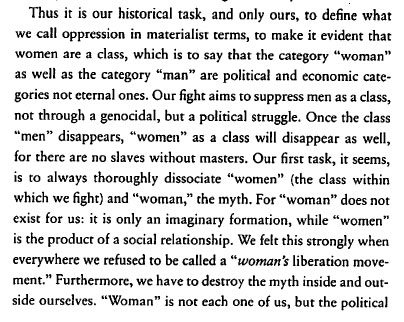
Monique Wittig, from "One is Not Born a Woman," 1981, thanks to Terry R. Myers for sending me a PDF so promptly!
Donna Ruff: Jen, thanks for posting that, it’s a good read. I guess removing myself from a literal reading of the show, I’d still characterize myself as, in her words, “admiring but distinctly nervous.”
Mira Schor: Jen, thanks I’ll take a look..actually don’t think my students are watching TV.
Jen Bradford: I don’t mean you (or they) have to watch or approve of the show – but it could tell you something more complex about where they’re coming from.
Mira Schor: absolutely
Terry R Myers: Mira – I just sent you an email (with the PDF of Monique Wittig’s essay)
Monika Weiss: Regarding the UNIVERSAL DECLARATION OF HUMAN RIGHTS, the problem, the old problem is with our body. When does it cease to be “Everyone” simply because it is impregnated or even “almost impregnated”, on its way to be such, thus the life of a woman as only and mainly the live of a future mother and not a life of an equal citizen [one of the great books on this is “Women and children first: feminism, rhetoric,and public policy” which is a look at policies that make this view dominant] . If according to some, “Everyone” begins in the “seed” itself, and wherever that “seed” lands, is a land occupied by it, so to speak, then women cease to be subjects of such declaration of rights, soon after they have been “landed” … (contraception rights debate being the current example) — this is an old medieval argument (in Western tradition Virgin Mary is a vessel but not a full human being-no other agency–and in my mind I imagine her always already beheaded) — this is all returning full speed now, “the reproductive rights” debate having repercussion for other areas of human rights, including gay rights in a sense that of course if the marriage is an assumed act of an official procreation the it is not a union of two independent human lives… [the question remains, what discourses and actions are appropriate now, in light of the loss of real Left]
Kikuko Tanaka: For me…. feminism is the sets of interdisciplinary knowledge that brings justice to all the people, through the emancipation of the people in the feminine status, including women, sexual dissidents, the poor, non-whites, foreigners, immigrants, children, the insane and the criminalized.
It is sad that the Universal Declaration of Human Right still remains our goals to be achieved, and despite the UN’s declaration and its humanitarian efforts, the UN itself has also functioned as an another form of empirism: western domination of the racial others.
Republicans are too backward in the country presumed to be advanced. We have more and more knowledge about how oppression and domination work. But how can we make real changes? Voting and protests are important, but they do not seem enough. What do we do?
Mira Schor: Monika and Kiko, so we are at an impasse? (I mean if the Declaration of Human Rights is seen as a flawed document by the global “left”, and honored mainly through being ignored and breached, because if I understand correctly, it is the product of the Enlightenment, which itself seems devalued by all sides, from the left because it was a product of the patriarchal, colonialist West and by the right for all the reasons we can imagine (poor stupid enslaved people make it easier for rich people to have total power)…not expecting any of us to have an answer
Kikuko Tanaka: I don’t want to think that we are at an impasse! though sometimes, I cannot escape that feeling…
Yes…Universal Declaration sounds right and comforting on the surface, but idea of “right” itself presupposes the existence of an “individual autonomous being” who are entitle to possess “property.” It is true that idea of human rights has helped to improve general work condition, but with an intention to prevent the rises of socialism….
Emily Caigan: I am joining late, but if it’s ok – I’ll jump in. I usually start teaching Feminist Art and Culture by reading The Declaration of Sentiments from the Seneca Falls Convention. The 1st wave feminist issues helps ground the conversation – especially since men and women of color were very active ( the race issue became problematic later). Gender Studies is an important topic mostly for third wave and LGBTQ for second wave. Basically it reminds us about many rights that we did not have 100 years ago and that women in other countries don’t have today. THEN we get into art and culture. I may do this in order to keep my sanity :).
Mira Schor: Emily, very interesting to hear how you organize your course. I’ll keep it in mind. As you say, start with life and general history, not with art. I have thought about starting a version of this course next year with statistics relating to women’s rights from beginning of second wave and from now, to focus on actual rights and lack thereof, actual facts about women’s lives, because I think that there is a sense of “the way it was” and now with huge gaps of knowledge about life for women at both ends of the time frame.
A thirty year old woman today may find it hard to really understand that 40 years ago she would have had no significant women teachers in graduate school and few role models in the art world, but at the same time she may also not realize to what degree sexism still exists at the center of what seems on the surface like a much improved world. This is something I myself find surprising: 40 years ago I never dreamed that at this point in my life I would be up against deeply ingrained patriarchal operations within my most inner circle in the art world, despite so many gains, and that it would be so much harder to cope with because it is embedded within networks of friends and supporters, and because it is unspoken, even with a strong support network of like-minded women: the lack of a larger movement makes it impossible to point to something and say, look, look at what is going on here. And of course I’m no longer protected by the gloss of youth, which always helps a lot and may insulate the student generation, as it did me to some extent: but I came of age during the women’s movement and very significantly I had seen in my teens how my mother fared when she was widowed, young, how society had favored the man and the couple, and how difficult it was for a woman alone, and how heroic any woman is who battles through on her own talent and wits.
Monika Weiss: The UNSPOKEN is the key word here, I agree, and the impossibility to “point at it” because of the apparent lack of a larger movement (although I would like or hope to believe that we don’t need a glow of youth to deal with this). Yes, there has been some progress and female graduate students today have some wonderful women role models to look up to. But there is a new kind of resistance to this “progress” within graduate environment– and the art world in general — some, the opponents, point out that this thing, let’s call it feminism at al, is “not so interesting” anymore, or as that which “has been done before”– this despite the Wack! etc. and other recent exhibitions resurrecting early feminisms in art). There is an uncanny level of reversal embedded in this process too akin to the political reversal going on today. But somehow I still maintain a basic trust in the promise of education. P.s. and yes, I also agree with Emily Caigan that we need to teach Feminisms [in any of the contexts of contemporary art] by first discussing the main historical and socio-political contexts etc.
Emily Caigan: I should mention that my course does not exist in Art History dept., but instead in Women’s Studies, along with a course that is called Performing Feminism. I was once called a “threat” because of my teaching and my students only receive AH credit if they are BFA majors. I appreciate these conversations immensely on FB. Mira, your story about your mother would be vital to an intro in any women’s studies class. It’s moving to me. My mom was a young widower and right up until she died in 2010, she said to me, ” You have no idea…”. Monica, ( hi, btw) It is absolutely the ” problem that has no name.” Here we are trying to name it.
Monika Weiss: responding to the earlier question about our condition of suspension inside an “impasse”–yes, I believe we are. It
It is still the same old problem with modernity and its multiple shadows. The Declaration offers a pretty good path, but we still disagree on the subject of who is a human being and who is not. Or perhaps, what it exactly entails and for whom. There is still a problem with our shallow and diversified understanding of equality of human rights–which are acceptable when they are offered within our own circle but not so crucial for “others” and elsewhere. And then there is again the problem of body, especially body marked by otherness, thus the body that is female, gay, colored is still an “obstacle” for the individual who inhabits such marked body–since white male and straight body is still being Privileged. This has also economic consequences. So the battle for gender equality as the battle for human rights, is and has always been the SAME with all other battles that take on otherness and power structures. Why this impasse though? Perhaps because we somehow managed to convince younger generations of women (and workers and some of the third world etc.) — that the battle has been won, at least on the policy level, or at least in the “developed” world. The level of shame or ‘threat’ that comes with even those words “feminism” or “socialism” is the unexpected twist or result of the lack of vigilance. I guess I am going in circle here, where all roads lead to Left, and the Left is being mourned by us in this conversation. [Meanwhile Chicago is demonstrating, and, as I said before, I still have some trust in education, in universities and in cities, as places that a certain potential is honed…]
Susan Silas: re: Girls, it seems pretty generation specific. My daughter, who is about 5 years younger doesn’t seem to relate to it….I still think there is something meaningful in the category “Woman” despite the theoretical discourses that put emphasis elsewhere because 51% of the world’s population is considered biologically female and the political backlash is against all of those persons no matter how they self-identify. Some of the stratification in the women’s movement developed because of insensitivity to the concerns of women with different identifications and experiences due to race and class and that splintering has never really been mended or adequately addressed but it allows some male intellectuals to dismiss feminism as a form of identity politics by listing it along with a list of very the specific identity concerns of much smaller groups when the overall concern is one of over half the population. Somehow, the question needs to be reformulated but not by letting go of the entire category unless there is really a better one to supplant it strategically.
*
The conversation above took place May 20. Today’s New York Times featured the following front page story, above the fold, “THE NEW AMERICAN JOB: More Men Enter Fields Dominated by Women.”
More than a few men said their new jobs had turned out to be far harder than they imagined.
But these men can expect success. Men earn more than women even in female-dominated jobs. And white men in particular who enter those fields easily move up to supervisory positions, a phenomenon known as the glass escalator — as opposed to the glass ceiling that women encounter in male-dominated professions, said Adia Harvey Wingfield, a sociologist at Georgia State University.
For men, the glass escalator, instead of women’s two traditional possibilities in that fragile material, the glass slipper and the glass ceiling. Yes, let’s all get on that.

